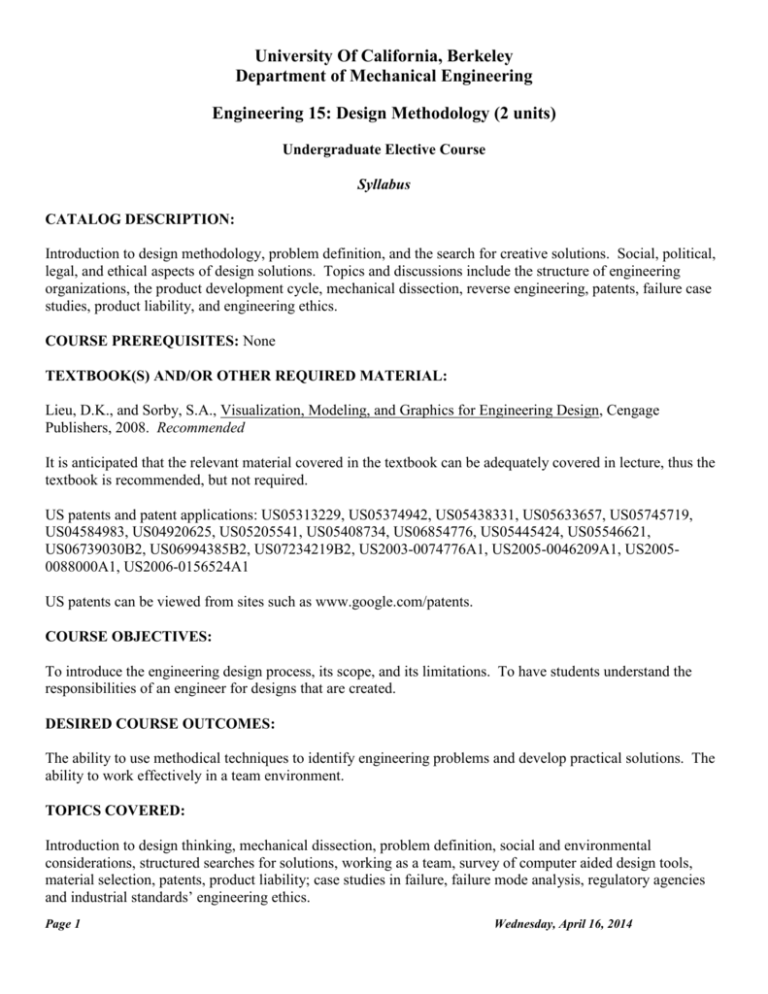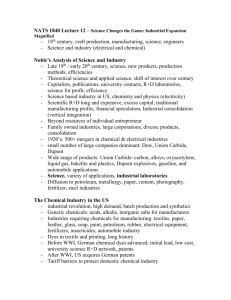Design Methodology - Mechanical Engineering
advertisement

University Of California, Berkeley Department of Mechanical Engineering Engineering 15: Design Methodology (2 units) Undergraduate Elective Course Syllabus CATALOG DESCRIPTION: Introduction to design methodology, problem definition, and the search for creative solutions. Social, political, legal, and ethical aspects of design solutions. Topics and discussions include the structure of engineering organizations, the product development cycle, mechanical dissection, reverse engineering, patents, failure case studies, product liability, and engineering ethics. COURSE PREREQUISITES: None TEXTBOOK(S) AND/OR OTHER REQUIRED MATERIAL: Lieu, D.K., and Sorby, S.A., Visualization, Modeling, and Graphics for Engineering Design, Cengage Publishers, 2008. Recommended It is anticipated that the relevant material covered in the textbook can be adequately covered in lecture, thus the textbook is recommended, but not required. US patents and patent applications: US05313229, US05374942, US05438331, US05633657, US05745719, US04584983, US04920625, US05205541, US05408734, US06854776, US05445424, US05546621, US06739030B2, US06994385B2, US07234219B2, US2003-0074776A1, US2005-0046209A1, US20050088000A1, US2006-0156524A1 US patents can be viewed from sites such as www.google.com/patents. COURSE OBJECTIVES: To introduce the engineering design process, its scope, and its limitations. To have students understand the responsibilities of an engineer for designs that are created. DESIRED COURSE OUTCOMES: The ability to use methodical techniques to identify engineering problems and develop practical solutions. The ability to work effectively in a team environment. TOPICS COVERED: Introduction to design thinking, mechanical dissection, problem definition, social and environmental considerations, structured searches for solutions, working as a team, survey of computer aided design tools, material selection, patents, product liability; case studies in failure, failure mode analysis, regulatory agencies and industrial standards’ engineering ethics. Page 1 Wednesday, April 16, 2014 CLASS/LABORATORY SCHEDULE: One hour of lecture and 2 hours of laboratory per week CONTRIBUTION OF THE COURSE TO MEETING THE PROFESSIONAL COMPONENT Students learn the basic design process, but will also learn limitations and expectations from social, political, ethical, and legal constraints. Students will be formally trained in how to work effectively in teams. RELATIONSHIP OF THE COURSE TO ABET PROGRAM OUTCOMES (c) an ability to design a system, component, or process to meet desired needs within realistic constraints such as economic, environmental, social, political, ethical, health and safety, manufacturability, and sustainability (d) an ability to function on multi-disciplinary teams (e) an ability to identify, formulate, and solve engineering problems (f) an understanding of professional and ethical responsibility (g) an ability to communicate effectively (h) the broad education necessary to understand the impact of engineering solutions in a global, economic, environmental, and societal context (i) a recognition of the need for, and an ability to engage in life-long learning (j) a knowledge of contemporary issues (k) an ability to use the techniques, skills, and modern engineering tools necessary for engineering practice. SEMESTER PROJECT A semester design project will be required as a part of this course. The design will be a paper design only. Although graphical images will be required, there is no requirement for hardware build. Suitablity for hardware build will, however, be a consideration for grading of the project. At the beginning of the semester, students will be presented with a market need for a product. An example (consistent with the sample homework exercises present below) is the design of a product to help remove stubborn arrows from targets for archery. Students are to design a product that fills the need, considering economic, social, political, and legal factors. The purpose of the project is to give students an introductory experience in the design of a consumer product, and an introductory experience in working in a team environment. Students will work in teams of 3 – 5, and part of the project grade will be assigned to each student by that student’s teammates. The required aspects of the project include: Identification of a need. Definition of the problem. Specifications of the boundaries (constraints and restrictions for design). Search for existing solutions. Search for possible new solutions. Complications from existing patents or other social, political or legal factors. Visual and graphical communication. Written communications. Oral communications. Students will be expected to dedicate 2 – 3 hours per week to the project. To ensure timely progress selected portions of the project will be integrated into the weekly homework assignments. Additionally, there will be a Page 2 Wednesday, April 16, 2014 design review during the 9th week of class. The design review will be oral. A final written report and a final oral presentation will be due at the end of the semester. ASSESSMENT OF STUDENT PROGRESS TOWARD COURSE OBJECTIVES Weekly homework assignments 20% Midterm examination (2 hours) 20% Final examination (3 hours) 30% Semester project. 30% SAMPLE OF WEEKLY AGENDA: Week Lecture Topics Recoomemded Reading 1 Creativity and the Design Process Lieu & Sorby Chapter 5 2 Working in a Team Environment Lieu& Sorby Chapter 4 3 Patents and the patent process US patents and applications 4 Patents, con’t US patents and applications 5 Design visualization Course notes 6 Design Analysis Lieu & Sorby Chapter 8 7 Industrial Standards and Regulatory Agencies 8 Technical Communication 9 Project Engineering 10 Failure Analysis 11 Case Study: Sampoong store failure 12 Product Liability 13 Case Study: Meat Grinders 14 Case Study: Sinking of the Amoco Cadiz 15 Working as a Professional Engineer Week Laboratory exercises 1 Course notes Identification of market needs. Identification of Constraints and Restrictions. Exercise: Develop a device for harvesting ripe fruit from a tree. 2 Page 3 Ideation: brainstorming, structured search. Sketches. Selection matrix and selection. Wednesday, April 16, 2014 3 Formation of project teams. Drafting of team contract. 4 Introduction to the semester project. 5 Patent reading exercise, identification of independent and dependent claims, infringement analysis. 6 Introduction to design visualization software. 7 Design software, con’t. Analysis software. 8 Midterm exam. 9 Design review of semester projects. 10 Mechanical dissection of a toy helicopter. 11 Mechanical dissection of a disk drive. 12 Discussion of Sampoong store failure. 13 Discussion of Amoco Cadiz failure. 14 Review of Goodrich Aircraft Brake Scandal case. 15 Final project presentations. Sample homework assignments HW #1 1. Develop a Team Contract for your Team. The contract should specify how each member has agreed to function, how and when the Team will meet to work together, and how the Team will communicate. The contract must be signed and dated by every member of the Team. 2. Investigate current products that assist in the removal of arrows from a target. Your report should include an image of each product, a short description of its operation, its retail price, and at least two suppliers from where it can be purchased. HW #2 1. Using brain-storming and brain-writing methods, develop at least twenty different concepts for a product that will remove stubborn arrows from a target. Illustrate these ideas with sketches. 2. Develop a decision matrix to assist in the selection of a viable product, based upon reasonable product attributes and their relative importance to the product. Identify the five most viable options for a successful product. HW #3 Page 4 Wednesday, April 16, 2014 1. What rights does a patent give the inventor? What rights are not given to the inventor? (10%) 2. What types of things are patentable, and what types of things are not? (10%) 3. Explain the difference between independent and dependent claims in a patent. Provide examples. 4. If your invention is similar to one that has already been patented, what features must be present in your invention in order to infringe upon that patent? (10%) HW #4 Search for relevant patents on products that facilitate the removal of arrows, with target or field points only, from targets. Create a list of your findings which include the title, patent number, date, inventor(s), an image, and a short (30 words or less) summary of each patent. HW #5 Based on the findings of your patent search, re-evaluate your concepts for new arrow removal devices from your previous assignment. Generate new concepts, and a new decision matrix as needed. Recommend two viable new products that will not infringe on the patents you have discovered. HW #6 Prepare a technical report summarizing the results of your search for arrow puller products and patents. Include all aspects of a technical report, as was outline in class. You may copy some, or all, of the material you submitted previous homework in this class to include in this assignment. HW #7 Given the failure probabilities in the figure below, find x, the probability of failure for Aileron 1 and Aileron 2. (10%) HW #8 1. What were the results of the court hearing for Goodrich aircraft brake case study? Was this a clear-cut case of ethical wrong-doings? Elaborate your answer. Page 5 Wednesday, April 16, 2014 2. Describe three common ways in which engineering units are organized, and the advantages and disadvantages of each structure. HW #9 Prepare a final technical report summarizing the results of the design or your arrow puller, from initial concept to final proposed product. Include all aspects of a technical report, as if you were submitting the report to a client company that had hired you to develop such a product. You may copy some, or all, of the material you submitted for HW #1-3 to include in this assignment. There is a 3000 word cap on the text in the report; there is no cap on the number of figures. HW #10 Submit an evaluation of the performance of the other students on your project team. Assign each person on your team up to 20 points, based upon participation and quality of work. A person who fully participated in the project, and provided good quality work should be awarded the full 20 points. A person who did not participate can be assigned zero points. In most well-functioning groups, everyone receives 20 points. If you wish, you may include a short description of why each person deserved the score you assigned. Your scores and evaluations will remain confidential. Your evaluations are due at the same time as the final report. PERSON(S) WHO PREPARED THIS DESCRIPTION Dennis K. Lieu 7 April 2014 ABBREVIATED TRANSCRIPT TITLE (19 SPACES MAXIMUM): DES METH TIE CODE: LABS GRADING: Letter SEMESTER OFFERED: Fall and Spring COURSES THAT WILL RESTRICT CREDIT: None INSTRUCTORS: D. K. Lieu DURATION OF COURSE: 15 weeks EST. TOTAL NUMBER OF REQUIRED HRS OF STUDENT WORK PER WEEK: 6 IS COURSE REPEATABLE FOR CREDIT? No CROSSLIST: None Page 6 Wednesday, April 16, 2014





